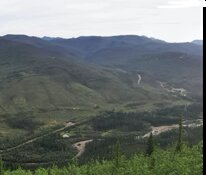The Gold Report: Junior mining companies are facing what John Kaiser has called the mother of all bear markets and have had a tough time raising money at reasonable valuations. What are your thoughts on that? Is there a light at the end of the tunnel?
Richard Karn: No. We continue to see more junior mining companies failing from here and have been waiting for a final wash out of the junior mining sector for some time.
At the end of the day, capital is the most vital of all resources in producing commodities, and too much capital has been misallocated in the last few years for there to be a sudden resurgence in lending, especially to the junior mining sector. And as we all know, global commodity prices as measured by the S&P GSCI index are down 34% over the last year due to overcapacity and overly rosy projections about future pricing power and consumption and emerging market growth and endless expansion, etc.
Less discussed, however, is the way this misallocation of capital is likely an unintended consequence of years of unprecedented capital injections by central banks globally, which is more than mildly ironic because the Federal Reserve blamed the global financial crisis on the "surfeit of savings globally." As with the housing bubble in the run-up to the global financial crisis, there was such a thorough relaxing of lending standards, not to mention the push to "get deals done," that projects and expansions that should not have been funded were, and now the world is awash in not only oil and iron and cotton and labor but also capital itself.
"Alkane Resources Ltd. is uniquely positioned to become the first company to offer primary mine supply of hafnium."
Belatedly, institutional capital today is increasingly anxious because resource investments made over the last few years are now money-losing positions from this rapid collapse in commodity prices. The knock-on effects have yet to play out, but the market seems to be fervently hoping that commodity prices recover before the bond markets, especially the junk bond market, pitches a fit.
Think about it: institutional capital is now so scared it would prefer to in effect pay profligate governments and central banks a fee to use their money to do more of what has clearly not worked—only harder—than to tie up their funds in infrastructure or mining projects capable of producing a long-term return and benefitting the global economy. Such an approach to fiduciary responsibility smacks of that Mark Twain quip about seeking "a return of his money not a return on his money."
Negative interest rates can only be seen as a condemnation of failed interventionist policy. There can be no recovery until the excesses have been worked off, and we just don't see the resolve to make long-term commitments of capital returning any time soon—and today the junior mining sector is way down the list of possible investments.
Keep in mind that specialty metal projects were either drowned in capital, starving other arguably more deserving projects, or totally ignored, and now all have been left high and dry as capital recedes. Ironically, a number of the projects that were flooded with cash and have failed or are failing were projects that could not possibly have lived up to the frenzied hype because the specialty metals they produce were not what the market needed.
That's what happens when people do not understand what they are investing in—or why—and demonstrates how so-called industry professionals can be as guilty of shallow, shoddy research as a novice retail investor.
This is also why, despite the collapse in broad commodity prices, numerous specialty metal prices have held or even gone up in the last few years: companies with the potential to produce these metals couldn't attract capital, and the tightness today is now likely to become shortages tomorrow. Eventually the market will accept this new reality, and investment dollars will flow from "story stocks with potential" to producing operations.
When institutional capital eventually comes back to the resource sector, especially to the specialty metal sector, because it is scared, money will flow first to what has been proven to work, that means companies that are funded and in or nearing production now, which will be seen to be a tremendous advantage. Then, because mining costs will have declined so far and cost curves will have been re-based, improving especially private equity's return on investment, merger and acquisition activity will accelerate.
But private equity firms know the longer they wait, the more the resource sector will be starved for capital and the cheaper the deals will become. In other words, because they cannot be sure the bottom in commodity prices is in, they will wait for slam-dunks.
So no, generally speaking we don't see a light at the end of the tunnel for the majority of junior mining companies. That being said, specialty metal companies with good managements and good projects are still finding ways of getting funded and into production, and that is where investors need to be looking—at those companies that are getting the job done despite the collapse in commodity prices.
TGR: Are specialty metals companies, say those producing graphite, tungsten, rare earth elements (REEs), niobium, etc., in a better position than gold and silver companies?
RK: No. If anything, it's probably worse, but they are entirely different situations. Gold and silver is pretty easy to understand; the roughly 50 specialty metals we follow are anything but. Gold and silver are hedgeable, which is critical in securing commercial finance; most specialty metals are not.
For the last couple of years, gold, and to a lesser extent, silver companies with proven management and good projects have been able to secure funding because demand remains pretty robust. Over the last decade China has surpassed India as the premier gold buyer, but where India re-exports a portion of its gold, it appears that what gold goes into China tends not to come out again. Only something on the order of 12% of gold production is consumed, primarily in electronics—and most of that is easily recovered—so the global stock of gold increases every year with the majority going either into jewelry production or saved as a store of wealth.
Specialty metals are more utilitarian so their stocks are perpetually drawn down, but projects are difficult to get financed because many specialty metals are not hedgeable. Despite the aforementioned decline in commodity prices, which has certainly caught a number of specialty metal prices in the rip tide, demand and prices on the whole have held up pretty well because these metals are regularly consumed and must be replaced—and I'm not just talking about consumer electronics, but also about the specialty metals used in automobiles, household appliances, military materiel, renewable energy, super alloys, etc., all of which continue to consume specialty metals like there's no tomorrow.
There are exceptions, of course, but by and large only a few high value specialty metals, such as platinum, palladium, silver and gold, have economic recycling protocols, so every year we drain the finite global specialty metal resource base by that much more.
TGR: Is investor interest in specialty metal companies more closely tied to the larger economy or to a specific story?
RK: My experience has been that investor interest is geared toward a specific specialty metal story that both piques their interest and is easily understood. But I don't think the broad market appreciates what it takes to secure funding for a specialty metal project these days, or what a testament to management innovation and perseverance it is to get a project into production.
To take but one well-publicized example, the electrical storage sector has been attracting a great deal of attention recently. The Tesla/Panasonic lithium-ion battery 5-Gigawatt-hour Gigafactory is slated to consume about 25% of current global lithium production, 35% of current global graphite production and 15% of current global, non-Democratic Republic of Congo cobalt production.
Investors read that BYD, Foxconn, Apple, LG Chem and Samsung are all planning their own similarly sized lithium-ion battery Gigafactories and rightly conclude current supply of these specialty metals cannot possibly meet future demand, so they look to invest in companies producing these specialty metals. This is much easier said than done because what they find is that despite five years having passed and World Trade Organization (WTO) verdicts condemning certain behavior, the situation is largely unchanged and the world is still dependent on China for many of the most critical specialty metals. Further, the broader specialty metal space has been starved of investment capital for at least three years now, which means in real terms very few projects have been put into production.
Graphite was one of those specialty metals that everybody had to have a few years ago, and there were suddenly more graphite companies promoting their deposits and bad-mouthing others' projects than you could shake a stick at. And the best of them were years away from production—and still are.
TGR: Could you tell us about a graphite company that you like?
RK: Valence Industries Ltd. (VXL:ASX) is a graphite company that has largely escaped North American and European investor attention despite being in production today. For the last couple of years I've been modeling Valence in my presentations as one of three Australian specialty metal companies that has been "doing it right" in this dreadful funding environment: the company is actually producing graphite from its Uley Graphite project in South Australia—not talking about it, Valence is actually producing and selling graphite today.
TGR: That was a brownfield project, wasn't it?
RK: Yes, Managing Director Chris Darby and the board raised $22 million ($22M) during 2014, bought the project from Strategic Energy Resources Ltd., refurbished the plant that had been on care and maintenance for nearly 25 years, did a compliance listing on the Australian Securities Exchange and, after fighting through a jungle of red tape, put Uley back into production earlier this year.
Valence recently completed the processing of its first 1,500 tonnes of run-of-mine stockpiles and exported its first 20 tonnes of graphite products; it is currently ramping up production, which by Q3/15 should reach nameplate capacity of 14,000 tonnes per year (14,000 tpa). Flake size and purity have exceeded expectations, and customers are lining up for their graphite products for use in refractory, foundry, lubricant, battery, electronics and biomedical applications. Importantly, Valence has discovered a new, high-grade deposit adjacent to its first pit that has already led to a 43% increase in its JORC-compliant Ore Reserve, taking it to nearly 3 million metric tonnes (3 Mmt) at 12.1% graphitic carbon, and extending mine life to beyond eight years.
TGR: Valence Industries recently secured US$75M in loans. How will the company use the funds to add value?
RK: The loan facility will be drawn down in stages primarily to complete the current drilling program, to increase production in two steps to 39,000 tpa and then to 64,000 tpa, and to pay for the construction of both a materials handling facility and a new advanced manufacturing facility in Adelaide. This advanced manufacturing facility is what interests me most because this is where Valence upgrades its standard products into highly sought-after, higher-margin graphite products.
With a product line that ranges from $1,335/tonne to $3,819/tonne in price, the more of the latter Valence can produce, the higher its profit margins. Originally, the company was planning to upgrade about 5% of its next stage of production (39,000 tpa) to the high-margin product, which would have given it an average profit margin across its entire product line of about $890/tonne. But customer product approval and demand for the high-purity, large-flake product has convinced Valence to increase its upgrading capacity to about 40% of production, which will increase its average profit margin across its entire product line to about $1,650/tonne—an 85% improvement.
TGR: How important is it to secure an end user in the graphite market?
RK: End-user product approval is vital. Keep in mind that many specialty metals do not trade on an exchange so the pricing is often about as clear as mud; in numerous instances the specialty metal prices paid, as well as the customers' identity, are closely guarded secrets because they constitute a competitive advantage. The price you read about in the paper or on the Internet is often just a best guess. And when a company sells a whole range of products from the same deposit, as is the case with graphite, prices—as well as demand—are all over the place depending on flake size, purity, etc.
So Valence has spent a lot of time giving samples of its graphite line to potential customers, seeking product approval. To date, the company has received product approval from nine customers and has signed sales contracts for 8,000 tonnes of graphite. Valence also has multiyear memorandums of understanding pending product approval for contracts amounting to an additional 37,000 tpa.
TGR: What is the long-term growth trajectory for this company?
RK: I think Valence Industries is ideally positioned to profit from increased demand for graphite. I expect another significant upgrade in both the size and grade of the Uley deposits in the next six months or so.
Valence has gone through the typical specialty metal IPO insanity in which hot money in Australia and Asia chased the graphite fairy tale, and the share price ran from AU$0.20 up to about AU$0.65 in the first six months of trading. Then, as is usually the case, when Valence knuckled down and got to the hard work of actually going into production, the hot money lost interest and moved on to the next big thing and the price has drifted back down to AU$0.25 or so.
Some people take issue with the debt facility Valence has arranged in order to expedite expansion and improve profit margins, disregarding the fact that securing any financing at all in this market is testimony to the superior nature of the project. People doubt that at some point non-Sino supply of specialty metals like graphite are likely to command a premium. So Valence's share price has drifted down. But what's starting to replace the hot money are serious investors interested in accumulating a real long-term growth story, real graphite production, real profits.
Just as Elon Musk and Panasonic would not have funded the construction of their lithium-ion battery Gigafactory without securing supplies of the specialty metals they will require, neither will the other five companies mentioned above as having announced plans for Gigafactories of their own. When another lithium-ion battery Gigafactory breaks ground, supply of graphite will clearly get squeezed; if two or three more break ground, that will consume more graphite supply than currently exists globally, prices will explode, especially for the large-flake, high-purity product. Even assuming financing can be arranged, and there a number of graphite projects getting a lot of press, it takes a lot more time than people realize to put new projects into production, which puts Valence into a very good position strategically.
Uley is not on the drawing board; Valence isn't promoting its "potential." It is real; it is in production; it is fully funded to both quadruple production and to double its profit margins—right here, right now.
TGR: And this "right here, right now" aspect is critical to your overall specialty metal investment thesis, isn't it? Can you take a moment to explain that to our readers—and how it ties in to the companies under discussion today?
RK: Sure, but please understand we're not moralizing or condemning anyone: the situation simply is what it is; the West let the situation develop, and the West will continue to pay for the mistake. We just aim to profit from it.
Our investment premise regarding specialty metals is simply this: Any lingering notion that free market economics apply to specialty metals has been dispelled by China. Through a centrally planned policy decision, China has spent at least 35 years attempting to take control of the global specialty metal market—and it has largely succeeded.
Unburdened by labor, energy or materiel costs, not to mention competition or environmental concerns, China simply undercut the production costs of most specialty metal projects in the West, and the West with a "New Economy" focus on short-term earnings rather than long-term security of supply simply went along with it.
Then in 2010 when China used REEs as an economic cudgel against Japan over a minor fishing incident, the West finally caught a glimpse of the predicament their dogmatic belief that "free market economics will prevail" had landed them in. The West forgot that in war, even economic war, the first victim is always truth—and the second is always access to strategic raw materials.
Reflective of the litigious society we've become, our first response was "to sue the bastards" in the WTO, conveniently overlooking that China had never qualified for the WTO membership the West had ramrodded through in the aftermath of the dot.com bubble collapse—or more ironically that Wall Street had been heralding communist China as the "future of capitalism" for nearly a decade.
So by 2011, organizations like the British Geological Survey were falling over themselves decrying that China was the largest producer of 50% of the 52 elements, minerals and metals they had determined to be under critical supply threat; further, China produced more than 85% of a host of minerals including but not limited to graphite, tungsten and rare earth elements, which we're discussing today.
The West responded by throwing money at anything even vaguely resembling a specialty metal project, with the rare earth element projects becoming the poster child for this panicked, gross misallocation of investment capital. Five years on, there have been some stupendous failures, but the problems remain largely unaddressed. China still controls large swathes of the specialty metal space. As predicted, China is effectively thumbing its nose at the WTO ruling, simply replacing export quotas with taxes and production quotas, and pretty much doing as it damn well pleases while the West sputters impotently, and little real progress has been made in reducing China's control over specialty metals.
So my publication focuses on specialty metals projects that can be used to replace Chinese supply—but only if they are located in North America or Australia. We look at both brownfield projects that were shut down because the Chinese undercut the project on price, as well as at greenfield projects of extraordinary caliber that we believe will be funded despite the hostile environment. So of the three projects under discussion today, two are brownfield and one is greenfield, and thanks to its unique geology all three are located in Australia.
TGR: Valence Industry's Uley graphite project was one of these brownfield projects; what's the other?
RK: Carbine Tungsten Ltd.'s (CNQ:ASX) Mt Carbine project in Far North Queensland, which was once one of the largest tungsten mines in the world and was last operated as a joint venture by the Roche Brothers, Sandvik AB and Treibacher Industrie AG in the 1980s. It was a classic case of what I'm referring to as a perfectly good project that was operating profitably one day and mothballed seemingly the next. No management or labor problems, no decline in grade, no indication the deposit was being exhausted—it was just rendered unprofitable by the flood of cheap Chinese tungsten that suddenly appeared on the market.
So a few years ago, at a time when no commercial interest on the planet would fund putting Mt Carbine back into production, management scraped together the funds to buy a small, used processing unit and set about reprocessing tails from previous operations in order to recover what wolframite previous operations had missed and all of the contained scheelite, which hadn't been targeted at all by the visual sorting methodology employed at the time, to produce a tungsten concentrate for end users to evaluate.
What Carbine Tungsten demonstrated was not only how inexpensively these brownfield projects could be put back into operation, but also how low operating expenses can be, which has turned out to be competitive with Chinese tungsten projects today.
In the aftermath of the Chinese using REEs as a weapon, Japan was eager to start diversifying its supply of specialty metals away from a dependence on the Chinese, and Mitsubishi tried and then started buying Carbine Tungsten's tungstic trioxide (WO3) 72% concentrate. In fact, Mitsubishi liked the product enough to begin prepaying for all of the concentrate Carbine Tungsten could produce from the tails.
TGR: How important is Carbine Tungsten's relationship with Mitsubishi both to operations and symbolically?
RK: I would be hard-pressed to think of a better partner for Carbine Tungsten than Mitsubishi. Some people take issue with the idea that up to now Carbine Tungsten has being reliant on one customer for all its product sales, which we find ludicrous: had Mitsubishi not stepped up, the project may well have foundered. And Mitsubishi has been a very good partner with Carbine Tungsten; in fact, Jim Morgan, the managing director, frequently comments about the way Mitsubishi often has had more people on site conducting due diligence and research than he does running operations.
Symbolically, what better validation for your project can you ask for than to have one of the 50 largest corporations in the world as your primary offtake partner? In March of this year Mitsubishi and Carbine Tungsten agreed to terms and offtake conditions for a $15M loan to advance stage 2 of returning Mt Carbine to full production, which involves processing approximately 12 Mmt of ore stockpiled from previous operations.
The deal, which will be finalized within the next quarter, will enable Mitsubishi to purchase, at prevailing market prices, as much as 80% of stage 2 production of 76,500 metric tonne units (76,500 mtu) of tungsten concentrate per year starting in Q2/16 and then as much as 50% of stage 3 production of 270,000 mtu per year with the resumption of full scale hard rock mining.
TGR: What other catalysts should we be looking for from this company?
RK: Foremost is that Carbine Tungsten's management is currently engaged with another group of investors about securing the estimated $55M necessary to expedite a return to full mining operations. I have no doubt Carbine Tungsten is on the right track with its incremental approach to putting Mt Carbine back into full scale production, but if the company were able to secure funding to skip reprocessing entirely and go straight to mining larger volumes of higher grade ore in the open pit and adjacent deposit, we think the share price would go ballistic.
Are we counting on it? Not at all, but it is a distinct possibility, not least because of the current geopolitical situation.
I think it prudent to mention here that most people do not recognize that there are few metals more vital to either industry or the military than tungsten. Without it there would be no cutting tools, no super alloys, no armor piercing ammunition. Also, there is no shortage of hot spots globally, especially with tensions now rising because China has announced that it owns virtually the entire South China Sea and has started building an island and military base on some disputed shoals. Or the way it is looking increasingly unlikely that the U.S. will be able to deal effectively with ISIL without putting boots on the ground. Or the way things in Eastern Europe are deteriorating.
And strangely, we've just heard rumors the Chinese are now sniffing around Carbine Tungsten—and we would remind investors that in recent years Chinese companies have bought Australian specialty metal resource companies not to put them into production, but to ensure they did not go into production, thereby protecting market share.
TGR: What is your greenfield project? How is it looking?
RK: It is Alkane Resources Ltd.'s (ALK:ASX; ANLKY:OTCQX) Dubbo Zirconia project (DZP). The company received the last of its approvals from the New South Wales government in April. Ironically, where some "fairy tale stocks" are assigned dot-com-like valuations, real operating companies with real earnings are arbitrarily discounted.
The Emerging Trends Report has long maintained that Alkane Resources is a de facto exchange-traded fund for the Australian specialty metal sector in that its Dubbo Zirconia project will produce roughly 20 of the 50 specialty metals we believe to be under long-term supply threat. Alkane also happens to own and operate the Tomingley gold project effectively as a sideline—one that is throwing off about $20M a year in free cash flow—while it pursues the development of the DZP.
Exemplifying how poorly understood the specialty metal space remains, as well as the Alice-through-the-looking-glass markets today, fund managers are openly assigning a negative value to the DZP, which has resulted in Alkane trading for less than the net present value of its producing gold mine.
Underperformance by market darlings Molycorp Inc. (MCP:NYSE) and Lynas Corp. (LYC:ASX), which produce predominantly low-value light rare earth elements (LREEs), taint perceptions of other specialty metal mining projects; that must make sense somewhere, but to us it is akin to branding the Saudis as "frackers" because we're too lazy to do a little research.
The simple truth is that the DZP is a difficult but arguably the most promising, and certainly the most interesting, specialty metal project on the planet. The DZP's unique trachyte volcanic intrusive ore body hosts zirconium, niobium, light and heavy rare earth elements plus yttrium in a remarkably homogenous form that is readily soluble in sulfuric acid for processing. It is a monster deposit with an 80-year mine life and a megaproject price tag of $1 billion. That makes the name something of a misnomer: zirconium and zirconia products constitute about two-thirds of Alkane's product line by volume but only approximately 33% of its projected profit stream.
Alkane has been developing the DZP flow sheet for 15 years, the last eight of which have seen its demonstration plant at the Australian Nuclear Science and Technology Organization (ANSTO) perpetually fine-tune the flow sheet to the point it has been producing samples of its entire product suite for end-user evaluation for the better part of six years. And heavyweight end users like Treibacher are lining up to either buy, market or refine Alkane's products.
What has captured our attention recently, however, is that this constant optimization of the flow sheet for the demonstration plant at ANSTO has resulted in the addition of hafnium oxide to Alkane's product line—the significance of which is clearly not yet grasped by the market.
TGR: What's so important about hafnium?
RK: Hafnium is a peculiar metal, even by specialty metal standards. Because of its near identical chemical composition to zirconium, hafnium is widely considered to be the most difficult of all metals to separate and recover economically.
Historically it has been used in nuclear reactor control rods and rocket nozzles, but today well over half of all hafnium is consumed by the aerospace industry in super alloys for turbine blades (rotating parts) and vanes (stators).
ATI Inc. (ATI:NYSE) and AREVA SA (AREVA:EPA) are currently the largest producers of hafnium metal, which they recover as a byproduct of zirconium refining for the nuclear industry, and together account for well over two-thirds of global production of 50–60 tpa.
With demand for hafnium metal being in the 70–80 tpa range, however, the price has escalated and remained in the vicinity of $1,200/kilogram despite the aforementioned downturn in overall commodity prices. Both Airbus and Boeing are predicting strong continued growth in the commercial aviation industry (e.g., Boeing claims 35,280 new planes will be built by 2032), so we expect strong hafnium demand well into the future.
I won't pretend to tell you how they do it, but the fact that Alkane has a process that can now recover a high-purity hafnium oxide product will make Alkane the world's first primary mine supplier of hafnium.
And that is a big deal.
Hafnium is similar in this regard to another specialty metal we like a great deal, scandium, in that it is not demand for hafnium that is the limiting factor but its very availability due to it being supplied solely as a byproduct.
Myriad new and expanded uses await increased hafnium supply, and Alkane is uniquely positioned to become the first company to offer primary mine supply of roughly 200 tpa at the cost of little more than another circuit in its processing plant. Hafnium oxide trades for roughly half the price of the metal, or $600/kilogram.
One would expect a near quadrupling of supply of any specialty metal would result in lower prices, but reduced hafnium prices would also spur new uses and bolster demand. Over time, hafnium prices would find equilibrium, in all likelihood at lower prices, but even assuming prices are halved, 200 tpa would still represent $60M per year in additional revenues for Alkane for 80 years: you do the math.
The addition of hafnium to Alkane's product suite, and its importance to the aerospace industry, may well be the catalyst that gets the DZP funding commitments across the line. And once Alkane secures funding, the rerating of the stock will be substantial and will take the market by surprise—and Alkane will become another overnight success 15 years in the making.
It has always been thus in the mining sector.
TGR: Richard, thank you for your insights.
As managing editor of The Emerging Trends Report, Richard Karn has a broad, multidisciplinary background and a working knowledge of precious and specialty metals, as well as considerable research, analytical and writing experience. He has written for publications ranging from Barron's, Kitco and Fullermoney to Financial Sense Online.
Read what other experts are saying about:
Want to read more Gold Report interviews like this? Sign up for our free e-newsletter, and you'll learn when new articles have been published. To see a list of recent interviews with industry analysts and commentators, visit our Streetwise Interviews page.
DISCLOSURE:
1) The following companies mentioned in the interview are sponsors of The Gold Report: Alkane Resources Ltd. The companies mentioned in this interview were not involved in any aspect of the interview preparation or post-interview editing so the expert could speak independently about the sector. Streetwise Reports does not accept stock in exchange for its services.
2) Richard Karn: I or my family own shares of the following companies mentioned in this interview: Alkane Resources Ltd., Valence Industries Ltd. and Carbine Tungsten Ltd. I personally am or my family is paid by the following companies mentioned in this interview: None. My company has a financial relationship with the following companies mentioned in this interview: None. I was not paid by Streetwise Reports for participating in this interview. Comments and opinions expressed are my own comments and opinions. I determined and had final say over which companies would be included in the interview based on my research, understanding of the sector and interview theme. I had the opportunity to review the interview for accuracy as of the date of the interview and am responsible for the content of the interview.
3) Interviews are edited for clarity. Streetwise Reports does not make editorial comments or change experts' statements without their consent.
4) The interview does not constitute investment advice. Each reader is encouraged to consult with his or her individual financial professional and any action a reader takes as a result of information presented here is his or her own responsibility. By opening this page, each reader accepts and agrees to Streetwise Reports' terms of use and full legal disclaimer.
5) From time to time, Streetwise Reports LLC and its directors, officers, employees or members of their families, as well as persons interviewed for articles and interviews on the site, may have a long or short position in securities mentioned. Directors, officers, employees or members of their families are prohibited from making purchases and/or sales of those securities in the open market or otherwise during the up-to-four-week interval from the time of the interview until after it publishes.











































